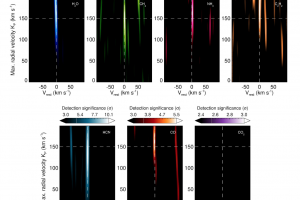The chemical composition of the Hot Jupiter HD 209458b tells us about its history. The study: “Five carbon- and nitrogen-bearing species in a hot giant planet’s atmosphere” of P. Giacobbe (INAF – OATo) recently appeared on Nature

The discovery of the first planet orbiting around another star occurred in the 1995, thanks to the astronomers Michel Mayor and Didier Queloz. This discovery set a milestone in astronomy both because it was the first observational confirmation of the existence of planets orbiting around other stars (in this case 51 Pegasi), and because of the nature of this exoplanet. It is, in fact, a gas giant orbiting on a very close distance around its star (about one tenth of the distance between the Sun and Mercury). The formation of planets of this type, called Hot Jupiters, is still controversial.
The widely accepted theory to explain the formation of the Hot Jupiters is that of the planetary migrations. The early evolution of planetary systems is quite chaotic, with frequent violent collisions, and processes in act that force planets to move radially toward or far away from their central stars. These migrations can be quite important for the chemical evolution of young planets. During these phases, in fact, planets are still embedded in the disk of gas and dust from which they are accreting mass, called protoplanetary disks. The chemical abundances of disks change with the distance from the central star, mainly because of the decreasing temperature and less intense intercepted stellar radiation. In this contest, important locations are the “snow lines” of given chemical elements, which are the locations in the disks at which the local temperature allows a given chemical element to condense. This means that closer than its snow line, the abundance of that element decreases, while it is more abundant for larger distances.
The study of the chemical composition of Hot Jupiters thus offers an important opportunity to understand the role of planetary migrations in the formation of this class of planets. To this aim, the team led by the astronomer P. Giacobbe (INAF – Astrophysical Observatory of Turin) have studied the chemical composition of the Hot Jupiter HD 209458b from observations acquired with the spectrograph GIANO-B, mounted on the Telescopio Nazionale Galileo. This is a well studied planet orbiting around a solar-type star at a distance of about 150 light years from the Sun. The astronomers have detected the presence of six new molecules in its atmosphere: water, carbon monoxide, hydrogen cyanide, methane, ammonia and acetylene. They also found that the atmosphere of HD 209458b is rich in carbon, with a C/O abundances ratio slightly larger than one (for comparison, in the Sun such ratio is 0.55). By comparing this finding with models describing the physical and chemical properties of protoplanetary disks, they concluded that HD 209458b formed farther than the water snow line, and in particular between the carbon dioxide and carbon monoxide snow lines, lying at a distance from the central star of 5-8 AU (Astronomical Unit, which is the average Earth-Sun distance, equal to 150 million km) and 30-40 AU, respectively, and then it migrated inward. The study is described in the paper: “Five carbon- and nitrogen-bearing species in a hot giant planet’s atmosphere“, recently appeared on Nature. The astronomers S. Benatti, A. Maggio, J. Maldonado e G. Micela of INAF – Astronomical Observatory of Palermo are co-authors of this study.
The figure (click here to visualize the entire image) shows the correlation between the GIANO-B spectra of HD 209458 b and synthetic spectra obtained from a model describing the atmosphere of the planet which also accounts for the presence of the given molecules. In each panel, the correlation is shown as a function of the velocity of the planet in the frame of reference of the planet itself (which is null by definition) and the maximum planet radial velocity (145 km/s). These values are marked with dashed lines. As shown by the bar over each panel, the colors indicate the significance of the correlation: larger values indicate stronger detection of the signal of the given molecule in the observed spectra.
Mario Giuseppe Guarcello ( follow mguarce) ( youtube)
Subscribe the Youtube of the Astronomical Observatory of Palermo
